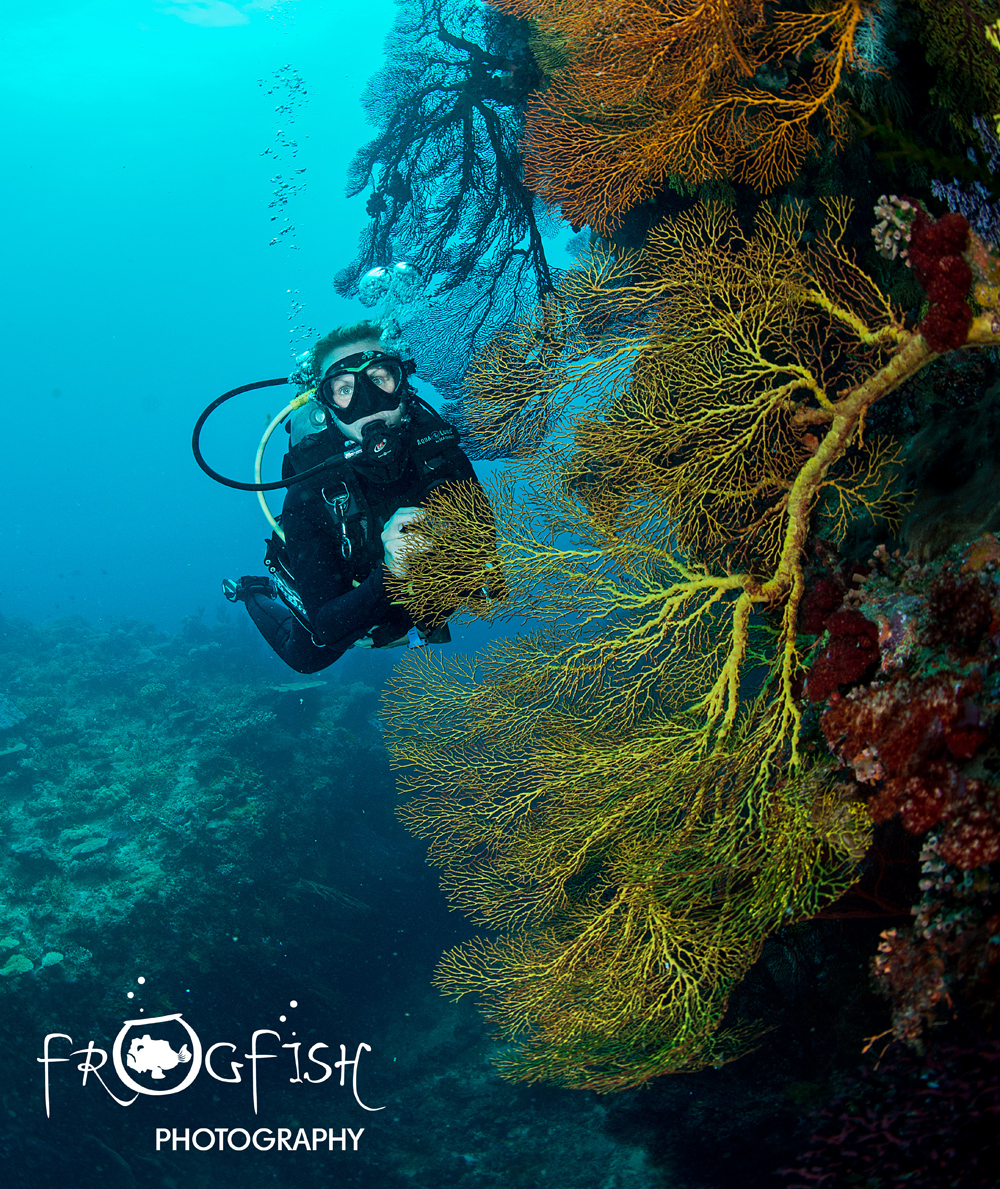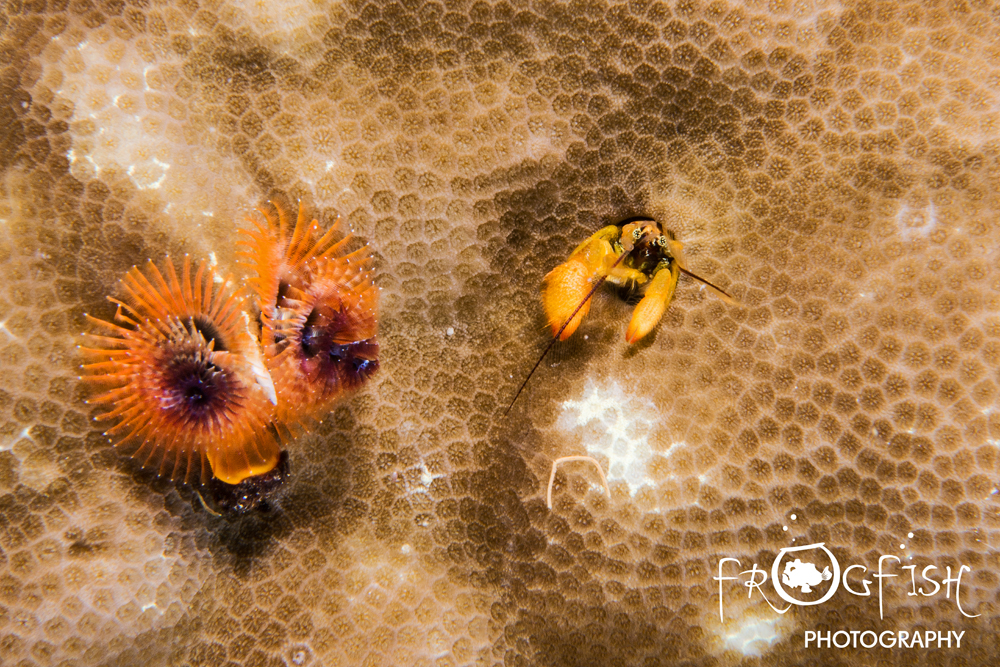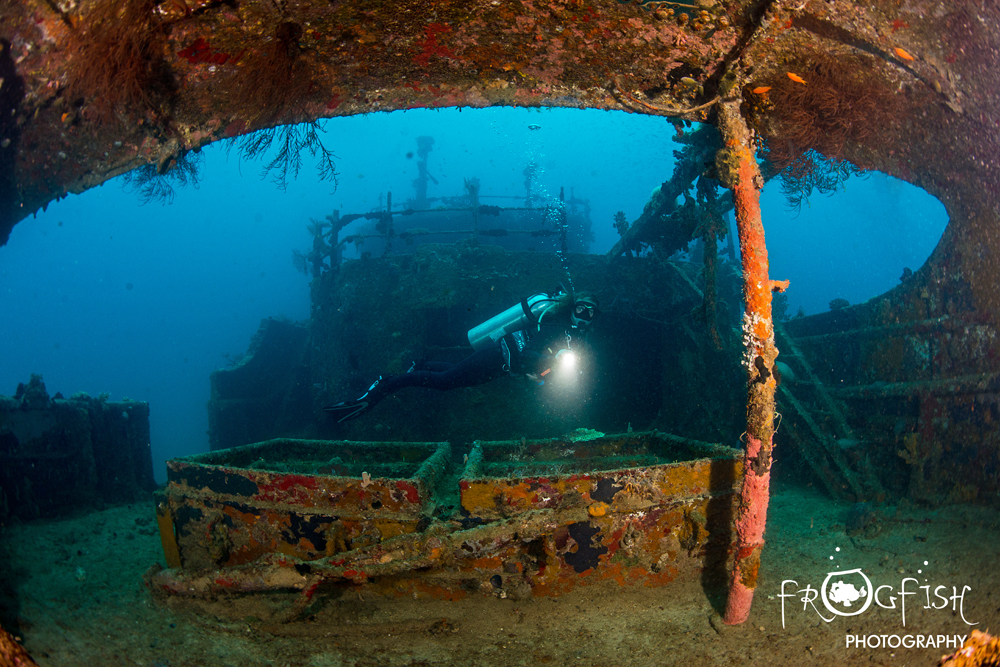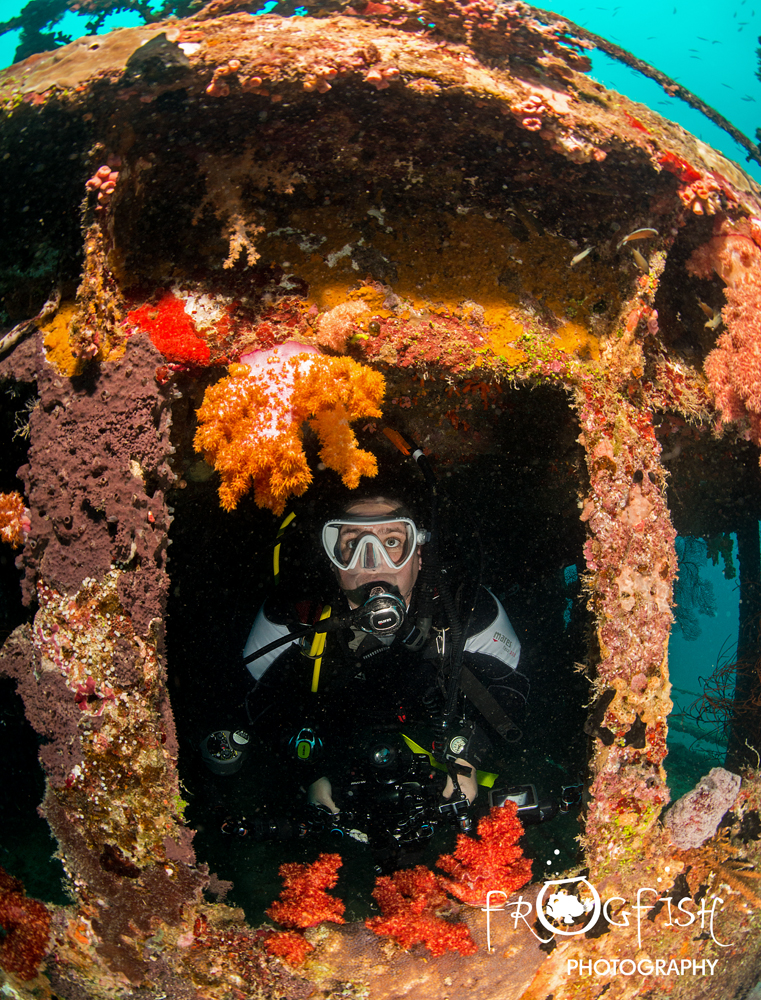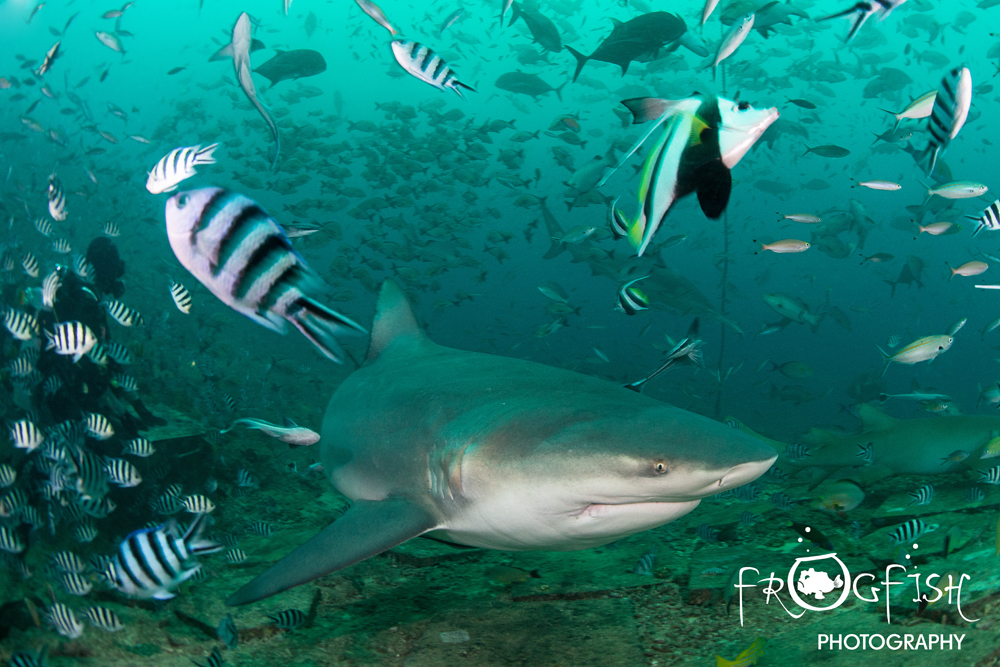News
Wonderful Waidroka
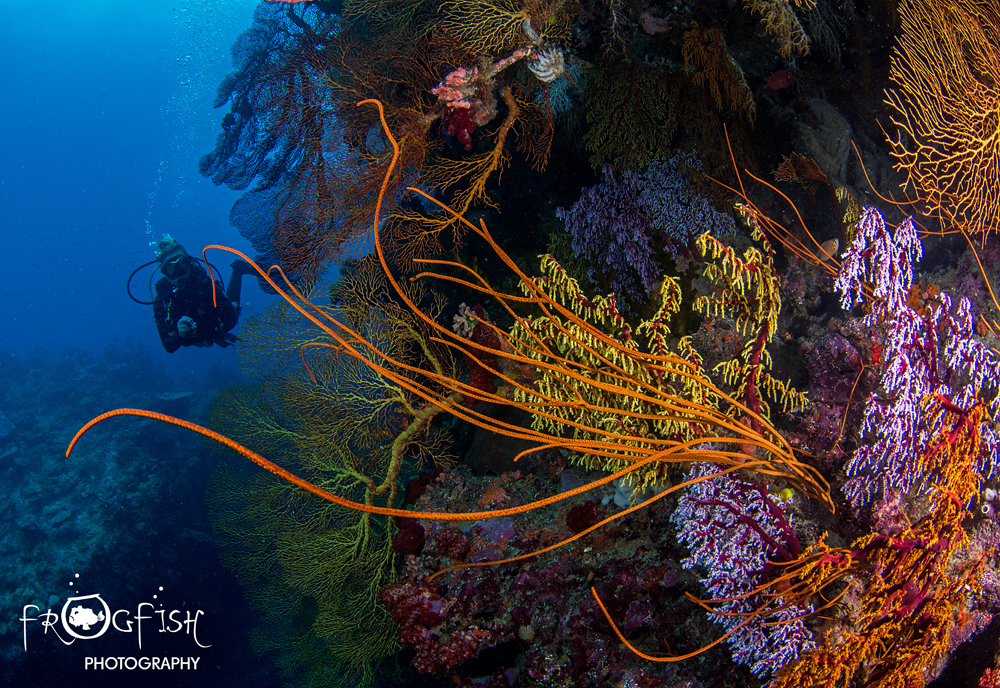
There is nothing like getting a warm welcome from all the staff when you first arrive at a resort, particularly when you are feeling more than slightly bedraggled from your journey. At Waidroka Bay Resort, we soon felt completely at home, and with all our bags whisked to our ocean front Bure (Fijian style bungalow), before we knew it, we were sat with the dive staff chatting about what the diving had to offer us the following day. We were to be the only divers on the boat, as a group had just left, which meant we had the choice of where to go – so we asked for them to take us to their favourite sites, of course!
All the meals at Waidroka are served “family style” with the guests and staff sitting around a communal table. You can opt to sit at a more private table or outside if you wish, but most like to sit and chat about the days diving and surfing with each other. The chef at Waidroka recently won Young Fiji Chef of the Year, which is an amazing accolade, and the food clearly reflected his talent. Not only was it delicious, but beautifully presented as well.
Our first day of diving was going to be based around the island of Yanuca. The dive centre has a close association with the villagers here, and the staff come to teach the school kids about the marine environment and wildlife each week. For us, it is the perfect place to relax between dives over a cup of tea, or lunch, whilst parked in the sheltered and secluded bay, with kids running around on the beach in the background. December is mid-summer here, so the schools were on a six week break.
Our first dive was at a site called Fantasea 1. Our guides, and head of watersports operations, Chelle and Warren, raved about this dive, so we just hoped it would live up to their enthusiastic tales. This has to be one of the best coral dive sites we have ever been on – no really! Fiji is famous for its reef diving, and this resort is at the heart of the Coral Coast, but even so, we were blown away by this dive site. Everywhere we looked the reef was packed with brightly coloured gorgonians, a rainbow of broccoli corals and numerous fish and critters hiding away on this fabulous reef. Chelle posed for us on the wall, diving through overhangs, gullies and swim-throughs, and with a maximum of 18m we stayed for well over an hour! How were we going to match this?
On our surface interval, we chatted about where to go next. Warren and Chelle told us about a site that was nearby, the Tasu II Wreck. Sunk in 1994, this was a 200 tonne Taiwanese fishing vessel, which had been confiscated for illegal fishing and deliberately sunk to create an artificial reef. She sits upright in the sand at just over 20m, depending on the tides. After over 20 years, plenty of animals have made their home here, and Warren went off to find the tiny pipefish that live on the roof of the wheelhouse, while we weaved our way around the structure, photographing the windows adorned with sea fans and capturing images of each of us framing our faces in the gaps. The dive is not over once you have finished exploring the wreck though, as you can extend your bottom time by swimming the short distance to Seven Sisters reef, a series of seven pinnacles that reach up to 5m, so you can select your safety stop pinnacle. Anthias, in pink and orange, in their thousands pulse to the rhythm of your breathing and strobe guns. It is truly magical.
Back at Yanuca Island, we relax and have some lunch. The chef has prepared packed lunches for each of us, which we are ready for. Our final dive site was another assault on our senses. Vivid colours on every available surface; it is easy to see why Cousteau called Fiji “the soft coral capital of the world”.
Alas, an incoming front was causing the wind to pick-up and we were starting to get worried about the diving being cancelled the next day. You could see that we were not the only ones concerned as Warren kept disappearing to check his weather apps over the course of the evening. After another scrumptious dinner, he called us over to brief us on the shark diving that we were due to do in the morning. The diving was going to depend on the weather in the morning, so we had everything crossed – this was one dive we had been looking forward to for weeks.
The shark dive that the Waidroka team take you on is run by the founders of this event, Aqua-Trek. The boat ride to Beqa (pronounced Benga) Lagoon is about 30 minutes away, and, whilst the weather was not ideal, we were delighted that the dive had not been cancelled and eagerly jumped on-board. Heavy rain overnight meant that the water was looking a little green from the run off from local rivers. However, it also kept away many of the boats that would usually come for this dive, so at least we could look forward to a more personal experience. Aqua-Trek’s boat pulled up with only 4 or 5 divers, so there would only be 7 divers, plus the shark feeders and wranglers in the water. As Fiji has some strong currents, the dive site is setup with a series of lines to guide you down to the correct shark feed location. The main stars of the show are Bull and Tiger Sharks, although you may also see Lemon, Nurse and various species of reef shark as well. The divers line up behind a wall, with the feeders in front to tempt in the sharks with fish heads that are donated by local fishermen and resorts. Usually it is the Bull Sharks that get the food, with the other species being wary of getting in their way, and you can see why when you get on the dive. Even with the visibility reduced and the water a little green, the experience is incredible, as huge bull sharks come in for their snacks. Surprisingly, they do so in an astonishingly calm manner, never rushing and appear content to circle around if another is already feeding. We were very fortunate to be invited into the feeding circle to kneel next to the feeders for an even closer encounter. One Bull Shark took a liking to Nick and came right up to his camera, stopping just in front of the dome port to say hello, before the wranglers gave her a polite nudge to move her along. All too soon, it was time to end the dive. We stayed as long as we were allowed to watch these magnificent sharks circle below us, but the visibility was getting worse, and we had to head back to the boat.
Alas, the weather finally beat us, and the second shark-feed dive was cancelled, as the visibility was getting worse, and the shark feeders could not see the sharks coming. It was the right call, but we were bitterly disappointed. We just had to remind ourselves how privileged we had been to get the first dive at all. The waves had also picked up, so the boat captain was eager to get us back closer to the resort. Within the reef system, the waters were a bit calmer, and so we decided to pop-in and dive one of the teaching sites near the resort. Waidroka has a pontoon for guests to sunbathe on and to use as a base for snorkelling and swimming. The best thing about it, though, if you look closely between the wooden slats, is that this is where many of the Banded Sea Kraits (sea snakes) come to warm themselves during the day. It is the first time we have seen this behaviour.
Our final night was to be a traditional Fijian evening of Lovo (food cooked in a BBQ pit), Kava (the local drink made from pepper plant roots) and music. We donned our Fiji Tourism Sulus (traditional Fijian skirts) and Scubaverse polo shirts and joined in the fun, the music and dancing. It was with not a small amount of sadness though, as we were leaving in the morning and, quite rarely for us, we really did not want to depart! We loved our time at Waidroka. The diving was great, the staff were all wonderful and so the whole experience was a joy. Maybe we will be able to come back sometime; we would certainly jump at the opportunity.
Find out more about Nick and Caroline at www.frogfishphotography.com.
Blogs
Northern Red Sea Reefs and Wrecks Trip Report, Part 3: The Mighty Thistlegorm

Jake Davies boards Ghazala Explorer for an unforgettable Red Sea diving experience…
Overnight, the wind picked up, making the planned morning dive a bit bumpy on the Zodiacs to the drop point on Thomas Reef. There, we would dive along the reef before descending through the canyon and then passing under the arch before ascending the wall with a gentle drift. The site provided great encounters with more pelagic species, including shoals of large barracuda, tuna, and bigeye trevally.
Once back on the boat, it was time to get everything tied down again as we would head back south. This time, with the wind behind us, heading to Ras Mohammed to dive Jackfish Alley for another great gentle drift wall dive before then heading up the coast towards the Gulf of Suez to moor up at the wreck of the Thistlegorm. This being the highlight wreck dive of the trip and for many onboard, including myself, it was the first time diving this iconic wreck. I had heard so much about the wreck from friends, and globally, this is a must on any diver’s list. Fortunately for us, there was only one other boat at the site, which was a rarity. A great briefing was delivered by Ahmed, who provided a detailed background about the wreck’s history along with all the required safety information as the currents and visibility at the site can be variable.

Kitting up, there was a lot of excitement on deck before entering the water and heading down the shoreline. Descending to the wreck, there was a light northerly current which reduced the visibility, making it feel more like the conditions that can be found off the Welsh coast. At 10m from the bottom, the outline of the wreck appeared as we reached the area of the wreck which had been bombed, as our mooring line was attached to part of the propeller shaft. Arriving on deck, instantly everywhere you looked there were many of the supplies which the ship was carrying, including Bren Carrier tanks and projectiles that instantly stood out.

We headed around the exterior, taking a look at the large propeller and guns mounted on deck before entering the wreck on the port side to take a look in the holds. It was incredible to see all the trucks, Norton 16H, and BSA motorcycles still perfectly stacked within, providing a real snapshot in time.

Overall, we had four dives on the Thistlegorm, where for all of the dives we were the only group in the water, and at times, there were just three of us on the whole wreck, which made it even more special, especially knowing that most days the wreck has hundreds of divers. Along with the history of the wreck, there was plenty of marine life on the wreck and around, from big green turtles to batfish, along with shoals of mackerel being hunted by trevally. Some unforgettable dives.

The final leg of the trip saw us cross back over the Suez Canal to the Gobal Islands where we planned to stay the night and do three dives at the Dolphin House for the potential of sharing the dive with dolphins. The site, which included a channel that was teeming with reef fish, especially large numbers of goatfish that swam in large shoals along the edge of the reef. These were nice relaxing dives to end the week. Unfortunately, the dolphins didn’t show up, which was okay as like all marine life they are difficult to predict and you can’t guarantee what’s going to be seen. With the last dive complete, we headed back to port for the final night where it was time to clean all the kit and pack before the departure flight the next day.

The whole week from start to finish on Ghazala Explorer was amazing; the boat had all the facilities you need for a comfortable week aboard. The crew were always there to help throughout the day and the chefs providing top quality food which was required after every dive. The itinerary providing some of the best diving with a nice mixture of wreck and reef dives. I would recommend the trip to anyone, whether it’s your first Red Sea liveaboard in the Red Sea or you’re revisiting. Hopefully, it’s not too long before I head back to explore more of the Red Sea onboard Ghazala Explorer.

To find out more about the Northern Red Sea reef and wrecks itineraries aboard Ghazala Explorer, or to book, contact Scuba Travel now:
Email: dive@scubatravel.com
Tel: +44 (0)1483 411590
Photos: Jake Davies / Avalon.Red
Blogs
Northern Red Sea Reefs and Wrecks Trip Report, Part 2: Wall to Wall Wrecks

Jake Davies boards Ghazala Explorer for an unforgettable Red Sea diving experience…
The second day’s diving was a day full of wreck diving at Abu Nuhas, which included the Chrisoula K, Carnatic, and Ghiannis D. The first dive of the day was onto the Chrisoula K, also known as the wreck of tiles. The 98m vessel remains largely intact where she was loaded with tiles which can be seen throughout the hold. The stern sits at 26m and the bow just below the surface. One of the highlights of the wreck is heading inside and seeing the workroom where the machinery used for cutting the tiles are perfectly intact. The bow provided some relaxing scenery as the bright sunlight highlighted the colours of the soft coral reef and the many reef fish.

Following breakfast, we then headed to the next wreck, which was the Carnatic. The Carnatic is an 89.9m sail steamer vessel that was built in Britain back in 1862. She ran aground on the reef back in 1869 and remains at 27m. At the time, she was carrying a range of items, including 40,000 sterling in gold. An impressive wreck where much of the superstructure remains, and the two large masts lay on the seafloor. The wooden ribs of the hull provide structures for lots of soft corals, and into the stern section, the light beams through, bouncing off the large shoals of glass fish that can be found using the structure as shelter from the larger predators that are found outside of the wreck.

The final wreck at Abu Nuhas was the Ghiannis D, originally called ‘Shoyo Maru,’ which was 99.5m long and built in Japan back in 1969 before becoming a Greek-registered cargo ship in 1980. The ship then ran aground on the reef on April 19th, 1983, and now sits at the bottom at a depth of 27m. Heading down the line, the stern of the ship remains in good condition compared to the rest of the hull. The highlight of the wreck, though, is heading into the stern section and down the flights of stairs to enter the engine room, which remains in good condition and is definitely worth exploring. After exploring the interior section of the ship, we then headed over to see the rest of the superstructure, where it’s particularly interesting to see the large table corals that have grown at the bow relatively quickly considering the date the ship sank. After surfacing and enjoying some afternoon snacks, we made sure everything was strapped down and secured as we would be heading north and crossing the Gulf of Suez, where the winds were still creating plenty of chop.

The next morning, it was a short hop to Ras Mohammed Nature Reserve for the next couple of days of diving. The 6am wake-up call came along with the briefing for the first site we would be diving, which was Shark & Yolanda. The low current conditions allowed us to start the dive at Anemone City, where we would drift along the steep, coral-filled wall. These dives involved drifts, as mooring in Ras Mohammed wasn’t allowed to protect the reefs. As a dive site, Shark & Yolanda is well-known and historically had a lot of sharks, but unfortunately not so many in recent years, especially not so early in the season. However, there was always a chance when looking out into the blue.

The gentle drift took us along the steep walls of the site, with plenty of anemone fish to be seen and a huge variety of corals. It wasn’t long into the dive before we were accompanied by a hawksbill turtle, who drifted with us between the two atolls before parting ways. Between the two reefs, the shallow patch with parts of coral heads surrounded by sand provided the chance to see a few blue-spotted stingrays that were mainly resting underneath the corals and are always a pleasure to see. With this being the morning dive, the early sunlight lit up the walls, providing tranquil moments. Looking out into the blue, there was very little to be seen, but a small shoal of batfish shimmering underneath the sunlight was a moment to capture as we watched them swim by as they watched us.

Towards the end of the dive, we stopped at the wreck of the Jolanda where the seafloor was scattered with toilets from the containers it was carrying. This provided a unique site to make a safety stop, which was also accompanied by a large barracuda slowly swimming by, along with a hawksbill turtle calmly swimming over the reef as the sun rays danced in the distance.
For the next dive, we headed north to the Strait of Tiran to explore the reefs situated between Tiran Island and Sharm El Sheik, which were named after the British divers who had found them. We started on Jackson before heading to Gordons Reef, where we also did the night dive. All the atolls at these sites provided stunning, bustling coral reefs close to the surface and steep walls to swim along, which always provided the opportunity to keep an eye out for some of the larger species that can be seen in the blue. Midwater around Jackson Reef was filled with red-toothed triggerfish and shoals of banner fish, which at times were so dense that you couldn’t see into the blue. Moments went by peacefully as we enjoyed the slow drift above the reef, watching these shoals swim around under the mid-afternoon sun.

The night dive at Gordon’s Reef was mainly among the stacks of corals surrounded by sand, which was great to explore under the darkness. After some time circling the corals, we came across what we were really hoping to find, and that was an octopus hunting on the reef. We spent the majority of the dive just watching it crawl among the reef, blending into its changing surroundings through changes in colour and skin texture. It’s always so fascinating and captivating to watch these incredibly intelligent animals, in awe of their ability to carry out these physical changes to perfectly blend into the reef. Before we knew it, it was time to head back to the boat to enjoy a well-deserved tasty dinner prepared by the talented chefs onboard.
Check in for the 3rd and final part of this series from Jake tomorrow!
To find out more about the Northern Red Sea reef and wrecks itineraries aboard Ghazala Explorer, or to book, contact Scuba Travel now:
Email: dive@scubatravel.com
Tel: +44 (0)1483 411590
Photos: Jake Davies / Avalon.Red
-

 News3 months ago
News3 months agoHone your underwater photography skills with Alphamarine Photography at Red Sea Diving Safari in March
-

 News3 months ago
News3 months agoCapturing Critters in Lembeh Underwater Photography Workshop 2024: Event Roundup
-

 Marine Life & Conservation Blogs2 months ago
Marine Life & Conservation Blogs2 months agoCreature Feature: Swell Sharks
-

 Blogs2 months ago
Blogs2 months agoMurex Resorts: Passport to Paradise!
-

 Blogs2 months ago
Blogs2 months agoDiver Discovering Whale Skeletons Beneath Ice Judged World’s Best Underwater Photograph
-

 Gear Reviews3 months ago
Gear Reviews3 months agoGear Review: Oceanic+ Dive Housing for iPhone
-

 Marine Life & Conservation2 months ago
Marine Life & Conservation2 months agoSave the Manatee Club launches brand new webcams at Silver Springs State Park, Florida
-

 News3 months ago
News3 months agoWorld’s Best Underwater Photographers Unveil Breathtaking Images at World Shootout 2023


